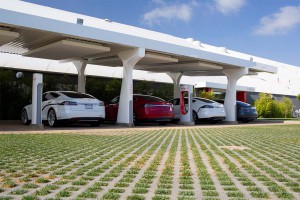
Tesla is expanding its Supercharger network in the U.S. and, Musk recently tweeted, aims to convert them to using solar power.
As quickly as President Donald Trump ended U.S. involvement in the Paris Climate Treaty, automakers – and more than 100 other companies – with equal speed said they planned to continue meeting the goals of the treaty.
The move so upset Tesla founder and CEO Elon Musk that he resigned from a committee that advises the president on a variety of business matters. However, not long after, a Twitter follower of Musk’s called him out, implying his stance was a bit hypocritical.
“Unfortunately I can stand at the Tesla superchargers and see the coal power plant. Play the shell game all you want these are coal powered,” wrote David Kennedy.
Musk immediately had an answer for Kennedy, also known as @ApexCornerSpeed on Twitter.
(Musk tells shareholders Tesla will need 10 or 20 assembly plants. For the story, Click Here.)
“All Superchargers are being converted to solar/battery power. Over time, almost all will disconnect from the electricity grid,” Musk tweeted back. It was fairly well known that Tesla planned to double the number available superchargers to 10,000 within the next 12 to 18 months, but moving them off the grid was a surprise.
While some may argue that Trump celebrated this technological effort by announcing the opening of the first new coal mine in decades, twitter followers were left to ponder one crucial question: when? When will they make the conversion? And how?
(Musk predicts Tesla will build 100K vehicles in 2017. Click Here for the story.)
Some of the stations were in the process of being changed over, but the number of solar panels needed to convert the sun’s rays into power for superchargers isn’t known. Experts suggest that for the largest charging stations – ones with more than 20 stalls – Musk will need a football field full of solar arrays, which seems less than ideal.
Of course, Musk didn’t elaborate how that would take place, but in his presentation about the solar shingles produced by SolarCity, he said the tiles on the roof would generate more than enough power to recharge a vehicle.
(To see more about a new global plan to increase EV sales to 30% of all new car sales, Click Here.)
Batteries would obviously store any additional energy produced by arrays. Ultimately, the key to the proposal is looking at the language Musk used in the response: “almost all.” It suggests that where it isn’t possible to disconnect from the grid and meet demand, the company won’t.
